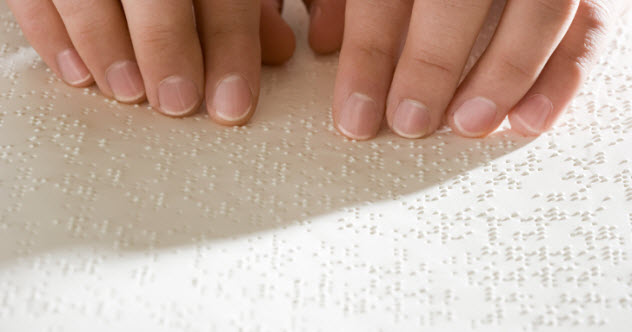 Movies and TV
Movies and TV  Movies and TV
Movies and TV  Creepy
Creepy 10 Eerie & Mysterious Ghosts of the Pacific Coast
 Weird Stuff
Weird Stuff 10 Typos That Accidentally Changed History
 History
History 10 Times Trickery Won Battles
 Technology
Technology 10 Awesome Upgrades to Common Household Items
 Misconceptions
Misconceptions 10 Hilarious (and Totally Wrong) Misconceptions About Childbirth
 Weird Stuff
Weird Stuff 10 Warning Labels That Exist Because Someone Actually Tried It
 Health
Health Ten Confounding New Inventions from the World of Biomedicine
 Creepy
Creepy 10 Death Superstitions That Will Give You the Creeps
 Movies and TV
Movies and TV 10 Movies That Get Elite Jobs Right, According to Experts
 Movies and TV
Movies and TV 10 Most Realistic Medical TV Shows of All Time
 Creepy
Creepy 10 Eerie & Mysterious Ghosts of the Pacific Coast
 Weird Stuff
Weird Stuff 10 Typos That Accidentally Changed History
Who's Behind Listverse?

Jamie Frater
Head Editor
Jamie founded Listverse due to an insatiable desire to share fascinating, obscure, and bizarre facts. He has been a guest speaker on numerous national radio and television stations and is a five time published author.
More About Us History
History 10 Times Trickery Won Battles
 Technology
Technology 10 Awesome Upgrades to Common Household Items
 Misconceptions
Misconceptions 10 Hilarious (and Totally Wrong) Misconceptions About Childbirth
 Weird Stuff
Weird Stuff 10 Warning Labels That Exist Because Someone Actually Tried It
 Health
Health Ten Confounding New Inventions from the World of Biomedicine
 Creepy
Creepy 10 Death Superstitions That Will Give You the Creeps
 Movies and TV
Movies and TV 10 Movies That Get Elite Jobs Right, According to Experts
10 Fascinating Insights Into The World Of Blindness
Most of us can’t imagine life without sight. Worsening eyesight is one of the curses of age, and some know nothing different. They’ve been blind since birth. Still, there have been some amazing findings on the science and psychology of blindness.
10 Deja Vu

Deja vu is defined as the feeling of having already experienced something that’s happening in the present time. As to how this happens, one theory is that there’s a slight delay between the time an image hits the eyes and when it registers in the brain. Although we’re still not sure if that’s true, it would seem to suggest that someone who’s blind can’t experience deja vu.
But strangely enough, they can.
The University of Leeds is at the forefront of deja vu research. Although the phenomenon is mildly annoying for most of us, it can be even more irritating for those who suffer from so-called “chronic deja vu.” The researchers also documented the first known case of a blind man who experienced deja vu, stressing that they’re almost certain there are more cases.
For the blind man, deja vu was triggered by a particular combination of events or activities. The official report gave the example of deja vu triggered by unzipping a jacket while a certain song played on the radio. He experienced the same feeling as he once had, which absolutely rules out the idea that deja vu is only caused by a blip in the optical nerve and pathways.
The blind man reported that the most common trigger was sound, from a piece of music to a snippet of conversation that created the sensation of familiarity. Often, sound combined with another sense, such as smell, to produce the feeling of having already experienced the same thing.
As a result, the researchers are moving away from a focus on a stimuli-based cause for deja vu. Instead, they’re developing a new theory that involves a disruption in brain signals and how that impacts our familiarity with certain experiences.
9 Navigating By Geomagnetism

Researchers from the University of Tokyo have been trying to determine if the brain can substitute nontraditional sensory inputs for a lack of visual stimuli. Recent tests on rats suggest that the brain absolutely can and that it can learn to interpret and “see” through other methods—including the use of geomagnetism.
The researchers outfitted blind rats with the same kind of digital compass that we have in our smartphones. Microelectrodes stimulated the rats’ brains and told them which direction they were facing. When they were facing north, that information was given to them by a stimulation of the right visual cortex. Facing south? A sensation in the left visual cortex.
The rats were then released into a maze, where the researchers found they were building a mental map of their surroundings using the information transmitted to them via the compass. Within two days, the blind rats were able to navigate as quickly and accurately as the control group (which could see). Behavior patterns from the blind rats indicated that it wasn’t just guesswork. They would head straight and then adjust their direction no matter which part of the maze they started in.
Yuji Ikegaya, the lead researcher, admits that he has no idea how the rats are forming such a complete mental map of the maze. But it does suggest that the brain can learn to use other types of input in place of visual stimuli and become just as agile when using it.
8 Universal Body Language

We often rely on body language for everyday communication. But it’s difficult to know whether it’s a skill we learn from others or one we have from birth. To find out, researchers from the University of British Columbia and San Francisco State University took a look at how different cultures express different emotions—like happiness and shame—through body language. While part of their study analyzed athletes who were participating in the 2004 Olympic Games, another part looked at something even more interesting: participants in the Paralympics.
The study included 108 people competing in judo, with 12 who were blind from birth and 41 who had lost their sight later in life. The researchers found that no matter what country these competitors came from, they all exhibited similar types of body language when they won or lost.
Photos of the athletes after the competition showed only the smallest variations. The sighted competitors from North American and European countries seemed to hide their shame and disappointment at a loss slightly better than the others. Blind competitors didn’t seem to emphasize this as much, suggesting that the athletes with sight were basing their reactions more in line with the cultural norms for their respective countries.
These results reinforce the idea that body language isn’t something that we need to learn from others. It’s just something that we all know across cultural lines and in some cases, that even joins us with our closest nonhuman relatives. From the slumped postures of the losers to the puffed-out chests of the winners, our body language is something that we share with animals like the gorilla and something that we don’t need to learn from others.
7 Blindsight
Blindness can occur in many ways. We usually think of it as a problem with our eyes, but in a handful of cases, that’s not true. Some patients—such as T.N. and D.B.—have what’s known as “blindsight,” the ability to perceive and respond to visual stimuli without realizing it.
T.N. was a doctor who suffered several strokes that impacted the visual cortex on both the left and right sides of his brain. While leaving his eyes capable of receiving information, the strokes appeared to destroy his brain’s ability to process the information.
At the University of Bangor in Wales, tests showed that T.N. had an uncanny ability to perceive his surroundings without being immediately aware of what he was doing. He could identify emotions on the faces of people in front of him, move to avoid obstacles in his path, and even identify the alignment of a rod on the wall. But he couldn’t detect light, as demonstrated when he was shown a flickering screen and asked to identify dark circles on it.
Similarly, D.B. had become half blind from an operation he’d undergone to cure chronic headaches. When given tests to determine how well his blind side could interpret visual inputs, he did surprisingly well in spite of his insistence that he couldn’t see anything.
But this doesn’t happen just when navigating a hallway or dodging obstacles. Patients with blindsight have been shown to have physical reactions to some stimuli. In particular, they often show signs of stress when looking at a picture of a terrified person.
Even scientists who have interviewed and tested subjects with blindsight aren’t sure what’s going on, but it may be related to V1, the part of the brain that’s believed to translate stimuli into our consciousness and make us aware that we’re receiving information. When V1 is damaged, there’s a disconnect between the information our brains are receiving and what we’re aware of receiving, allowing some blind people to react to information they don’t even realize is there.
6 The Advantage Of Having Blind Parents

Making eye contact is an important part of bonding at any age, and for babies, it’s one of the first ways they learn to interact with others. A team at Birkbeck, University of London, decided to study how the lack of eye contact experienced by the babies of blind parents impacted them in their earliest months of development. The research produced some surprising results. Apparently, these babies developed a work-around for communication using skills not found in the babies of sighted parents.
The communications skills of these babies and their parents were observed when the infants were six to 10 months old, 12 to 15 months old, and 24 to 47 months old. The babies with blind mothers made eye contact with and related to sighted people as any other baby would, but they also had quicker response times than their peers born to sighted parents.
While the babies of blind mothers were found to look at their mothers less than their peers did, their interactions with other adults were much the same as their peers. These babies also developed other ways of communicating with their blind mothers.
For example, the babies of blind women were more vocal when dealing with their mothers than with other adults or even their own fathers, so it’s not surprising that the babies of blind mothers also demonstrate better visual memories and communication skills than their counterparts. The researchers believe it’s similar to when babies grow up in bilingual homes. They learn multiple ways to communicate with those at home and derive long-term benefits from developing these communication skills earlier in life.
5 Dreams Of The Blind

As recounted in the journal Sleep Medicine, Danish researchers recruited 50 volunteers to study the difference in dreams between sighted and blind people. The group included 14 people who had been blind from birth, 11 people who became blind after their first birthday, and 25 people who were sighted. For one month, the volunteers recorded any details they could remember about their dreams, including colors, emotions, people, and other sensory impressions.
While none of the blind participants reported anything visual, almost 20 percent of them were able to taste in their dreams, 70 percent remembered touching something specific, and 86 percent heard sounds. All of these percentages were much higher than the sighted control group. Of the participants who had been blind since birth, 93 percent reported sounds. Interestingly, although the emotional content of most regular dreams was about the same for everyone, the blind were far more likely to experience nightmares.
For those who were born blind, about 25 percent of their dreams were nightmares, much higher than the average of 6 percent for sighted people. One blind participant reported being plagued with certain nightmares for her entire life, often dreaming that she was falling, being followed, or had been hit by a car.
Others dreamed of relentlessly embarrassing social situations. Researchers believe that the higher percentage of nightmares experienced by blind people may be connected to the dangers they face in their daily lives, with the frequency of those nightmares related to the increased processing time that blind people need to commit those potential dangers to memory. Dreams are supposedly a way of cementing experiences into memories. If so, the frequent nightmares of the blind are likely a reinforcement of survival skills.
4 Visualizing The World

In addition to varying degrees of blindness, there are also a surprising number of ways in which blind people visualize the world.
According to Paul Gabias, who went completely blind just after birth, he has no trouble seeing his surroundings in his mind. From height to depth to texture, it’s as vivid to him as it is to any person with sight—with one major difference. His mental images have no color. Black and white doesn’t exist for him, either.
A psychologist and professor from the University of British Columbia, Gabias has been studying how a blind person creates mental maps of his surroundings like a sighted person does. From a series of brain-imaging scans, it appears that the neural pathways creating mental maps in sighted people are the same pathways that work for the blind.
Information, such as that in Braille letters, goes through the visual cortex and is processed in the same way as visual inputs. The same is true for people who use other sensory inputs to echolocate. That information goes through the visual cortex. In fact, volunteers who listened to recordings of themselves using tongue clicks to navigate received so much information from the sounds that they could identify the objects that were producing the echoes on the recording.
Others have different visual responses. BBC journalist Damon Rose went blind from surgery as a child and now reports that he misses the darkness. He now sees an almost overwhelming amount of light that never goes away, regardless of the time of day or what he’s doing. He describes seeing a brown background, colorful geometric shapes, clouds, and squiggles. At first, his “built-in fireworks” gave him the hope of seeing again. But now, he’s certain that his brain is creating pictures for him because it no longer receives any visual inputs.
3 Ghosts And The Phantom Eye Syndrome

A lesser known version of phantom limb syndrome, phantom eye syndrome (PES) occurs in people who are blinded by the complete removal of one or both eyes. When the Liverpool Ocular Oncology Center decided to do an in-depth study on PES, they found some things that were expected. Their subject base, which consisted of people who had lost an eye to cancer between 4 months and 4.5 years earlier, reported phantom pains in their missing eye and the sensation of seeing things that weren’t there. Many saw fireworks or kaleidoscope-like auras, but a surprisingly high number also saw ghosts.
Some PES patients reported seeing strangers just at the edge of their peripheral vision. One woman woke up one night to see a strange, ghostly figure standing by her bed, while another regularly saw a strange person walking beside him. A third woman reported that she could see ghostly figures whenever it was dark. Yet another patient said that he could see people moving at the edge of his vision, but they invariably disappeared when he looked their way.
The question of whether or not the blind are more likely to see ghosts isn’t a recent one. An 1887 edition of Chambers’s Journal of Popular Literature, Science and Art contains an article about the subject. The author says that he knows ghosts don’t exist, but the blind are uniquely equipped to see them. After all, we’re all spectral, ghostly images to a blind person, argues the author, so the ghosts seen by a blind person are absolutely real.
2 The Tricky Belief In Other Superpowered Senses

The Montreal Neurological Institute headed up a study to determine how much hearing improves with blindness and whether musical talent improves as well. The researchers discovered that people who lost their sight at a young age were much better at identifying changes in pitch. But those who went blind when they were older had test results similar to sighted people. Apparently, a younger brain can assign areas once used to process visual information to handle other types of sensory input instead.
That’s a big difference from the theory that blind people just pay more attention to their other senses or that those senses become more acute. According to the research, an improvement in hearing or musical ability won’t happen to every blind person, and it may not be something that can be learned.
Another study from Georgetown University Medical Center looked at what was happening in the brain’s visual cortex when auditory stimuli were routed through it. When blind volunteers were asked to listen to sounds through headphones, their visual centers lit up. However, the visual centers of sighted volunteers remained all but dormant throughout this activity.
Compared to the brain’s auditory processing center, the visual cortex is about twice as large and complex. So while the blind might appear to have more acute hearing, it has less to do with their auditory system and more to do with their brain remapping itself to use the visual cortex in new ways.
1 Blindness And The Perception Of Race

Race is a tricky thing. For most people, it’s defined at least partially by skin color. So how do blind people perceive race, and just as importantly, what does that say about us as a species?
University of California law professor Osagie Obasogie interviewed people who had been blind from birth about their views on race. Many of his interviewees were offended by the idea that being blind would make them less aware of a person’s race and less racist. They didn’t believe that blindness created morally superior people.
If anything, Obasogie was surprised to find that many of his interviewees were more cognizant of skin color and racial differences than sighted people, mostly because the blind had learned through various social interactions that it was a big deal to most other people.
Obasogie is fascinated by what this says about racism, indicating that it’s deeper than the color of your skin. He found that race was just as important to the blind, with many sharing their ways of determining race before a conversation—or date—went too far. From reaching up to touch someone’s hair to being told not to rely on accents or speech patterns, many blind people have become just as preoccupied with determining someone’s race as sighted people.
Obasogie found that the topic was deeply polarizing for the people he interviewed. He concluded that the blind are no more or less racist than sighted people. But without the visual identification of race, it’s a purely social issue among the blind.
In his book Blinded by Sight: Seeing Race through the Eyes of the Blind, Obasogie said that race initially appeared to be driven by sight. To ignore race is often said to be color-blind, although his findings suggested quite the opposite. Based on his research, Obasogie believes that we need to reevaluate everything about our society’s beliefs on race, biology, and the differences between people.








